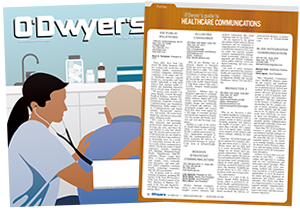 Sally Bain |
Listen to the ask
|
|
It’s important to always take a step back and listen, especially to those that live in the world of healthcare and technology. Take the opportunity to truly understand their needs and define a strategy that maps and aligns to their primary goals. It sounds rudimentary, but at the onset of the relationship, it’s essential to develop a detailed program that will immediately initiate trust. As healthcare marketers, we work with a number of emerging companies and at the onset of all of our relationships, we take the time to sit, listen and be a part of their world. Understand their challenges, take it all in and come back with an approach that fits their needs, instead of a PR-in-a-box campaign. This is particularly important for technology marketers joining the healthcare industry for the first time. It’s new to them; we must show them all the benefits and impact that the healthcare industry brings to the world on a daily basis.
Talk to, not at each other
There’s nothing more frustrating than two communications professionals saying the same thing but not actually understanding each other. This holds true across technology and healthcare — let’s all get on the same page and lose the “marketing speak.” When communicating on behalf of a brand, it’s essential that we’re addressing the industry need, the technology being applied to that ask, defining the market size and ultimately delivering the solution to market. We work with a number of companies that are answering industry needs and although it may be considered niche, it’s an unmet need. This holds true when applying this approach to reporters. Take them through a day in the life of the company. Ask yourself if you’ve taken the message and actually communicated what the brand is bringing to the market and how that will impact their reader’s world.
Leverage technology to drive metrics
Across industries, communications professionals have been challenged with hitting numerous audiences in a campaign: investors, patients, providers, etc. How do we ensure that we know where these influencers are consuming information? Technology, whether it be proprietary or through a third party, is essential to influencer mapping and ultimately delivering metrics that measure ROI. As part of our listening exercise, we take the opportunity to understand which metrics matter and how they will be shared within the company. More specifically, define how important engagement is and how influencer(s) can help to amplify a client’s message. Often times, physicians and hospital administrators are the most important influencers vs. analysts and reporters. Every influencer ecosystem is different for each company. Take the opportunity to understand that world before engagement.
All efforts can and should be measured. It’s important for PR and marketing agencies to show the value they’re bringing to companies across the technology and healthcare industries.
Take an integrated approach
The days of the one-and-done hit are gone. When assessing an opportunity, take an integrated approach, especially when the ask is to amplify content to a number of audiences. Microsites allow for engagement with patients, advocates and the general consumer typically seeking data around a particular disease state or treatment option. Microsites allow for the dissemination of thoughtful and accurate clinical data that may have been lost on the average consumer.
Paid social media has also been extremely effective in driving awareness, especially on Facebook, around campaigns and specific news announcements. The benefit of paid media also allows for brands to pivot; if it’s not working or showing the results you anticipated, make a change and do it quickly. Healthcare technology companies are striving and hungry for data that shows traction and immediate ROI.
Create consumable content
There’s an enormous opportunity to develop and amplify content that can be targeted, measured and effective. The lines of earned, contributed and paid media are blurred more often than not. We know that reporters, bloggers and influencers simply can’t keep up with the need for consumable content 24/7. By developing contributed content across marketing disciplines: earned, paid media and owned, there’s an opportunity to manage the peaks and valleys of the news pipeline and message and market penetration. Connect with influencers and reporters, like we all do with our clients, and learn about their needs. Ask the question of how we can work together while ensuring that we are both meeting our individual goals. Join forces with these influencers-it’s a win-win for everyone.
Ask yourself: is it working?
Sometimes it just doesn’t work. The traction isn’t happening. The reporter isn’t biting and the influencer isn’t engaging. Take a step back and ask yourself the key question: are the strategies and tactics that we’ve set forth really working and achieving our goals? If the answer is no, leverage the opportunity and assess the situation as opposed to continuing down the path of frustration. This is especially true with companies that are technology-based but servicing the healthcare market. Think about the story and the message and ask if it could be better suited for a technology reporter versus a healthcare reporter. As our media landscape continues to evolve, the trend has also been for some reporters and influencers to be more open to industry stories beyond their typical beat. Package the story to ensure it’s relevant and relatable to the audience and make a case for the story. Sometimes a little luck and a lot of timing plays into our efforts.
***
Sally Bain is Vice President of Racepoint Global.



 Lo Isidro, senior director at Real Chemistry with more than a decade of strategic communications and PA experience, has joined Narrative Strategies.
Lo Isidro, senior director at Real Chemistry with more than a decade of strategic communications and PA experience, has joined Narrative Strategies. Nelson Fernandez, former North American chair of APCO Worldwide and managing director of Burson-Marsteller, has joined Volunteers in Medicine Berkshires as director of communications and PA.
Nelson Fernandez, former North American chair of APCO Worldwide and managing director of Burson-Marsteller, has joined Volunteers in Medicine Berkshires as director of communications and PA. Lilit Bargar, who was most recently an EVP in the healthcare practice at Weber Shandwick, comes on board at GCI Health as EVP, corporate practice lead.
Lilit Bargar, who was most recently an EVP in the healthcare practice at Weber Shandwick, comes on board at GCI Health as EVP, corporate practice lead.
 Five ways that successful thought leaders are made.
Five ways that successful thought leaders are made.


 Have a comment? Send it to
Have a comment? Send it to 
No comments have been submitted for this story yet.